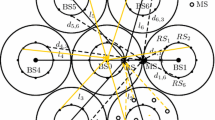Abstract
Relay stations are usually used to enhance the signal strength for the users near cell boundary, thereby extending the cell coverage. However, transmission through a relay station needs two transmission phases. The first phase is from base station to relay station, and the second one is from relay station to mobile station. Thus, using relay station may decrease system capacity due to two-phase transmission time. As a result, whether or not data are transmitted by one-hop or two-hop phases should be determined according to both signal strength and throughput. In this paper, we investigate the optimal relay location aiming to maximize system capacity. We consider two relay selection rules for determining whether two-hop transmission will be used: signal strength-oriented and throughput-oriented selection rules. We find that the signal strength-oriented two-hop transmission may yield even lower system capacity than the one-hop transmission. In the throughput-oriented scheme, the two-hop transmission can achieve higher system capacity than the one-hop transmission. By simulations, we determine the optimal relay location and show the coverage enhancement by the relaying network. Extensive simulations are performed to investigate the impacts of relay transmission power and the number of relay stations on system capacity and optimal relay location. The simulation results reveal important insights into designing a relaying network with high system capacity.











Similar content being viewed by others
References
Peters, S. W., Heath, J., & Robert W. (2009). The future of WiMAX: Multihop relaying with IEEE 802.16j. IEEE Communications Magazine, 47(1), 104–111.
Genc, V., Murphy, S., Yu, Y., & Murphy, J. (2008). IEEE 802.16j relay-based wireless access networks: an overview. IEEE Wireless Communications, 15(5), 56–63.
Pabst, R., Walke, B., Schultz, D. C., et al. (2004). Relay-based deployment concepts for wireless and mobile broadband radio. IEEE Communications Magazine, 42(9), 80–89.
Yanikomeroglu, H. (2002). Fixed and mobile relaying technologies for cellular networks. In the 2nd Workshop on applicaiions and services, in wireless networks (ASWN) (pp. 75–81). Paris, France, July 3–5.
Huang, J.-H., Wang, L.-C., & Chang, C.-J. (2006). Capacity and QoS for a scalable ring-based wireless mesh network. IEEE Journal on Selected Areas in Communications, 24(11), 2070–2080.
Huang, J.-H., Wang, L.-C., & Chang, C.-J. (2008). Throughput-coverage tradeoff in a scalable wireless mesh network. Journal of Parallel and Distributed Computing, 68(3), 278–290.
Huang, J.-H., Wang, L.-C., & Chang, C.-J. (2008). QoS provisioning in a scalable wireless mesh network for intelligent transportation systems. IEEE Transactions on Vehicular Technology, 57(5), 3121–3135.
Grossglauser, M., & Tse, D. N. C. (2002). Mobility increases the capacity of ad hoc wireless networks. IEEE/ACM Transactions on Networking, 10(4), 477–486.
Li, H., & Yu, D. (2002). Performance comparison of ad-hoc and cellular based routing algorithms in multi-hop cellular networks. In International symposium wireless personal multimedia communications (WPMC’02). Hawaii.
Irnich, T., Schultz, D., Pabst, R., & Wienert, P. (2003). Capacity of a relaying infrastructure for broadband radio coverage of urban areas. In Proceedings of 10th WWRF meeting. New York.
Gastpar, M., & Vetterli, M. (2002). On the capacity of wireless networks: The relay case. In Proceedings of IEEE INFOCOM 2002, vol . 3 (pp. 1577–1586). New York.
Wittneben, A., & Rankov, B. (2003). Impact of cooperative relays on the capacity of rank deficient mimo channels. In IST mobile and wireless communications summit (pp. 421–425). Portugal: Aveiro.
Sreng, V., Yanikomeroglu, H., & Falconet, D. (2002). Coverage enhancement through two-hop relaying in cellular radio systems. In IEEE wireless communication and networking conference (WCNC’02) (pp. 881–885). Orlando, USA.
Sreng, V., Yanikomeroglu, H., & Falconet, D. (2003). Relayer selection strategies in cellular networks with peer-to-peer relaying. In IEEE VTC fall (pp. 1949–1953), Orlando, FL.
Pabst, R., Esseling, N., & Walke, B. H. (2005). Fixed relays for next generation wireless systems-system concept and performance evaluation. Journal of Communications and Networks, 7(2), 104–114.
Viswanathan, H., & Mukherjee, S. (2005). Performance of cellular networks with relays and centralized scheduling. IEEE Transactions on Wireless Communications, 4(5), 2318–2328.
Wang, L. C., Chen, A., & Huang, S. Y. (2007). A cross-layer investigation for the throughput performance of CSMA/CA-based wireless local area networks with directional antennas and capture effect. IEEE Transactions on Vehicular Technology, 56(5), 2756–2766.
Senarath, G., Tong, W., Zhu, P., et al. (2007). Multi-hop relay system evaluation methodology (channel model and performance metric). IEEE 802.16j-06/013r3.
Stüber, G. L. (2001). Principles of mobile communication, 2nd edn. London: Kluwer.
Chandrasekhar, V., & Andrews, J. G. (2009). Uplink capacity and interference avoidance for two-tier femtocell networks. IEEE Transactions on Wireless Communications, 8(7), 3489–3509.
Viterbi, A. M., & Viterbi, A. J. (1993). Erlang capacity of a power controlled CDMA system. IEEE Journal on Selected Areas in Communications, 11(6), 892–990.
Ball, C. F., Humburg, E., Ivanov, K., & Müllner, R. (2005). Rapid estimation method for data capacity and spectrum efficiency in cellular networks. In Proceedings of 14th IST summit. Dresden, Germany.
Acknowledgements
This work was supported in part by the MoE ATU Plan, the Program for Promoting Academic Excellence of Universities (Phase II), and the National Science Council under Grant 98W803C, Grant NSC 97-2752-E-009-003-PAE, Grant 97-2221-E-009-097-MY3, Grant 97-2221-E-009-099-MY3, and Grant 96-2628-E-009-004-MY3.
Author information
Authors and Affiliations
Corresponding author
Rights and permissions
About this article
Cite this article
Huang, JH., Wang, LC., Chang, CJ. et al. Design of optimal relay location in two-hop cellular systems. Wireless Netw 16, 2179–2189 (2010). https://doi.org/10.1007/s11276-010-0251-5
Published:
Issue Date:
DOI: https://doi.org/10.1007/s11276-010-0251-5




